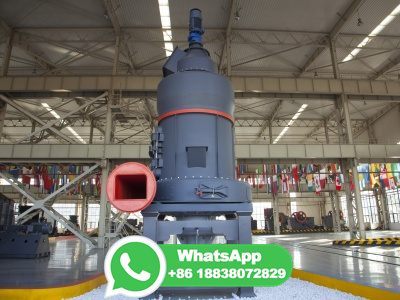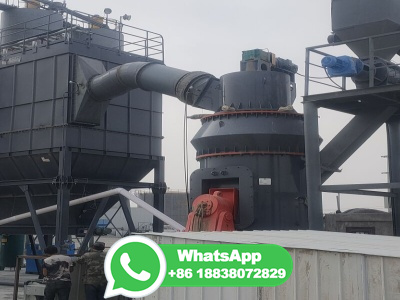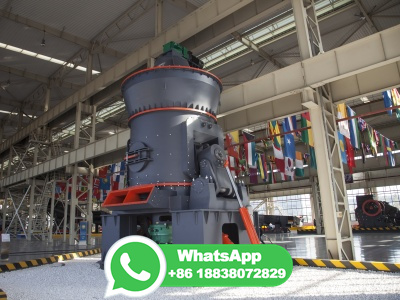
WEBThe chief reaction(s), occurring in blast furnace during extraction of iron from Haematite is/are: View Solution. Q4. Which of the following is the chief ore of aluminium? ...
WhatsApp: +86 18203695377
WEBA key step in the extraction of iron from its ore is FeO (s) + CO (g) = Fe (s) + CO2 ()K, at 1,000°C This step occurs in the 700°C to 1,200°C zone within a blast furnace. What are the equilibrium partial pressures of CO (g) and CO2 (g) when atm of CO (g) and excess FeO (s) react in a sealed container at 1000°C?
WhatsApp: +86 18203695377
WEBMineral processing, art of treating crude ores and mineral products in order to separate the valuable minerals from the waste rock, or gangue. It is the first process that most ores undergo after mining in order to provide a more concentrated material for the procedures of extractive metallurgy.
WhatsApp: +86 18203695377
WEBThe process of aluminium extraction by electrolysis. Extended tier only. Bauxite is first purified to produce aluminium oxide, Al 2 O 3. Aluminium oxide is then dissolved in molten cryolite. This is because aluminium oxide has a melting point of over 2000 °C which would use a lot of energy and be very expensive.
WhatsApp: +86 18203695377
WEBApr 14, 2024 · Its advantages over precipitation enable the wide appliion of the extraction method, which has been a research hotspot in the world in petrochemistry, hydrometallurgy, fine chemical industry, separation, and purifiion of biochemical extraction has been studied extensively due to the damage caused by .
WhatsApp: +86 18203695377
WEBCobalt ore. Cobalt extraction refers to the techniques used to extract cobalt from its ores and other compound ores. ... Iron and aluminum are removed from the leach solution by the addition of lime, ... The hydrometallurgical process for laterite ore can use sulfuric acid or ammonia leach solutions. Recovery from arsenide ores ...
WhatsApp: +86 18203695377
WEBOct 20, 2022 · Iron ore handling, which may account for 20–50% of the total delivered cost of raw materials, covers the processes of transportation, storage, feeding, and washing of the ore en route to or during its various stages of treatment in the mill.. Since the physical state of iron ores in situ may range from friable, or even sandy materials, to monolithic .
WhatsApp: +86 18203695377
WEBIron is extracted in a large container called a blast furnace from its ore, hematite. Modern blast furnaces produce approximately 10,000 tonnes of iron per day. The process is demonstrated and explained below: Diagram showing the carbon extraction of iron. The raw materials: iron ore (hematite), coke (an impure form of carbon), and limestone ...
WhatsApp: +86 18203695377
WEBNickel processing Extraction, Refining, Alloying: The extraction of nickel from ore follows much the same route as copper, and indeed, in a number of cases, similar processes and equipment are used. The major differences in equipment are the use of highertemperature refractories and the increased cooling required to accommodate the higher operating .
WhatsApp: +86 18203695377
WEB2 days ago · The basic extraction of metals from ores has the following steps. Grinding and Crushing. The bigger chunks of the ore extracted are crushed and ground in ball mills and crushers. It helps to increase the surface area of the chunks for better chemical actions later. In technical terms, it is called pulverisation.
WhatsApp: +86 18203695377
WEBFeb 17, 2024 · Iron Ore is a type of rock that contains iron minerals, mainly hematite and magnetite. It is a vital raw material for the production of steel. The ores are rich in iron oxides, which range in colour from dark grey to bright yellow to deep purple to rusty red. The most common iron minerals are magnetite, hematite, goethite, limonite, and ...
WhatsApp: +86 18203695377
WEBOre is defined as a source from where the extraction of metals takes place on a commercial and economical scale. The ores can be classified according to the metal present in it. ... The chief ore of Iron is formed by its oxide. Formula of chief Iron Ore. Hematite is the chief ore of Iron and higher content of Iron is present in such ore. It ...
WhatsApp: +86 18203695377
WEBSix steps to process iron ore. 1. Screening. We recommend that you begin by screening the iron ore to separate fine particles below the crusher's CSS before the crushing stage. A static screen is used to divert the fine particles for crushing. This step prevents overloading the crusher and increases its efficiency.
WhatsApp: +86 18203695377
WEBApr 23, 2024 · hematite, heavy and relatively hard oxide mineral, ferric oxide (Fe 2 O 3), that constitutes the most important iron ore because of its high iron content (70 percent) and its abundance. Its name is derived from the Greek word for "blood," in allusion to its red colour. Many of the various forms of hematite have separate names. The steelgray .
WhatsApp: +86 18203695377
WEBThe molten iron from the bottom of the furnace can be used as cast iron. Cast iron is very runny when it is molten and doesn't shrink much when it solidifies. It is therefore ideal for making castings – hence its name. However, it is very impure, containing about 4% by weight of carbon. This carbon makes it very hard, but also very brittle.
WhatsApp: +86 18203695377
WEBThe partially reduced ore is then smelted in the second unit, and liquid iron is produced. Smeltingreduction technology enables a wide range of coals to be used for iron making. Iron processing Ores, Smelting, Refining: Iron ores occur in igneous, metamorphic (transformed), or sedimentary rocks in a variety of geologic environments.
WhatsApp: +86 18203695377
WEBApr 4, 2023 · Extraction of Copper. Copper is extracted from its ore by a series of procedures, including mining, crushing, heating, chemically isolating impurities, refining, and purifying. Creating useful items from raw resources like copper ore requires a lengthy process but is possible with careful preparation and attention to detail.
WhatsApp: +86 18203695377
WEBJan 1, 2015 · The Pilbara region is rich in such hematite ore, known also as "direct shipping ore" (DSO). DSO passes through a simple crushing, screening, and blending process (beneficiation) before it is shipped for steel production. DSOs, when mined, typically have iron (Fe) content of between 56% and 64% Fe.
WhatsApp: +86 18203695377
WEBMercury processing Extraction, Refining, Recovery: The pyrometallurgical extraction of mercury from its ore is essentially a distillation process. When heat is applied to the sulfide ore in the presence of air, oxygen combines with the sulfur to form sulfur dioxide, and the metal is liberated at a temperature above its boiling point. The gases are then .
WhatsApp: +86 18203695377
WEBMay 22, 2024 · Hint: In order to answer the question, firstly we have to discuss the whole cycle of the extraction of metal from its ore and then conclude the process name from which the extraction of metal went through. Complete answer: The process of extracting metals from their ores is called metallurgy. The process employed in the extraction of .
WhatsApp: +86 18203695377
WEBJan 10, 2024 · Smelting is the process of extracting metal from its ore by heating it to a high temperature in the presence of a reducing agent. The reducing agent reduces the metal oxide to metal. The most commonly used reducing agent is coke (a form of carbon). The metal is then separated from the slag (the waste material) using various techniques. .
WhatsApp: +86 18203695377
WEBAug 10, 2022 · Figure 4: A Blast Furnace for Converting Iron Oxides to Iron Metal. (a) The furnace is charged with alternating layers of iron ore (largely Fe2O3) and a mixture of coke (C) and limestone (CaCO3). (b) This blast furnace in Magnitogorsk, Russia, was the largest in the world when it was built in 1931.
WhatsApp: +86 18203695377
WEBJul 12, 2019 · As you will see if you read the page about titanium extraction, this is the only way of producing high purity metal. TiCl4 + 4Na → Ti + 4NaCl T i C l 4 + 4 N a → T i + 4 N a C l. The more reactive metal sodium releases electrons easily as it forms its ions: 4Na → 4Na+ + 4e− 4 N a → 4 N a + + 4 e −. These electrons are used to reduce ...
WhatsApp: +86 18203695377
WEBThis is completed in the two processes (i) Calcination Process or (ii) Roasting Process (1) Calcination Process. Calcination may be defined as the process of heating the ore below its melting point in the absence of air. As a result of calcination, the following changes take place. Some hydrated ores become anhydrous.
WhatsApp: +86 18203695377
WEBAug 31, 2022 · Iron is the principal raw material for steel industries and Hematite is a principal ore of iron. Quantitative and qualitative estimation of iron in its ores is a crucial factor before its extraction. In this work, quantitative chemical analysis of iron was carried out from the collected seventytwo hematite samples from Pokhari, Nawalparasi.
WhatsApp: +86 18203695377
WEBThe chief Ore of zinc is zinc blende. The extraction of zinc from zinc blende involves the following steps. Concentration: The ore is crushed and then concentrated by frothfloatation Process. Roasting: The concentrated ore is then roasted in the presence of excess of air at about 1 2 0 0 k: 2 Z n S + 3 O 2 → Δ 2 Z n O + 2 S O 2
WhatsApp: +86 18203695377
WEB3 days ago · Iron, when extracted from iron ore such as haematite containing iron (III) oxide, Fe2O3, in a blast furnace is called iron extraction blast furnace metallurgy. In this reduction reaction, oxygen is removed from the iron (III) oxide to leave behind iron. Generally, the extraction of metals and their isolation are based on three major .
WhatsApp: +86 18203695377
WEBprocess of the extraction of iron is carried out by the following steps: 1) ... The chief reaction(s) occurring in blast furnace during extraction of iron from haematite is(are) : ... Medium. View solution > What is the role of limestone during the extraction of iron from haematite ore? Medium. View solution > View more. More From Chapter ...
WhatsApp: +86 18203695377
WEBExtraction Of Iron. May 22, 2009 • Download as PPTX, PDF •. 56 likes • 120,708 views. Sarbjit Singh. Follow. The Step by Step Process of Extracting Iron from its Ore using the Blast Furnace with details of Chemical Reactions. Question Answers based on the process of extraction of metals. Eduion Business Technology.
WhatsApp: +86 18203695377
WEBJul 31, 2023 · The HallHeroult process is predominantly used in the extraction of aluminium. In this process, pure Al 2 O 3 is mixed with CaF 2 or Na 3 AlF 6 . This lowers the melting point of the mixture and increases its ability to conduct electricity. A steel vessel with a lining of carbon and graphite rods is used.
WhatsApp: +86 18203695377
WEBJul 12, 2023 · The overall reaction for the production of iron in a blast furnace is as follows: Fe2O3(s) + 3C(s) Δ → 2Fe(l) + 3CO(g) The actual reductant is CO, which reduces Fe 2 O 3 to give Fe (l) and CO 2 (g) (Equation ); the CO 2 is then reduced back to CO by reaction with excess carbon. As the ore, lime, and coke drop into the furnace (Figure ...
WhatsApp: +86 18203695377
WEBJan 8, 2021 · Hypochlorite leaching system is a strong oxidizing solution for metal sulfides, which are naturally associated with gold extraction. This study evaluated the hypochlorite leaching of refractory gold ore by using the response surface method–central composite design (RSMCCD) as a statistical approach in determining the optimum condition of .
WhatsApp: +86 18203695377
WEBIron sheets are coated with zinc during galvanization. Name the solution used to react with bauxite as a first step in obtaining pure aluminium oxide,in the Baeyer's process. Write the equation for the reaction where the aluminium oxide for the electrolytic extraction of aluminium is obtained by heating aluminium hydroxide.
WhatsApp: +86 18203695377
WEBApr 5, 2023 · The blast furnace and direct reduction processes have been the major iron production routes for various iron ores ( goethite, hematite, magnetite, maghemite, siderite, etc.) in the past few decades, but the challenges of maintaining the iron and steelmaking processes are enormous. The challenges, such as cumbersome production .
WhatsApp: +86 18203695377
WEBLesson Plan. Students will be able to. relate the reactivity of iron to the extraction technique, describe the extraction of iron in the blast furnace, explain the role of limestone and coke in the process, write equations for the reactions at the different stages of the blast furnace, describe the different temperatures and reactions that ...
WhatsApp: +86 18203695377